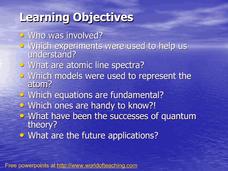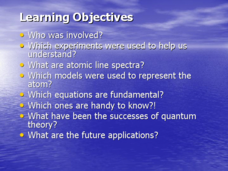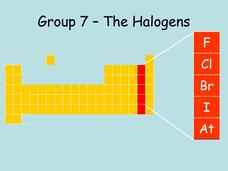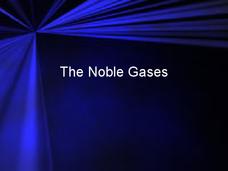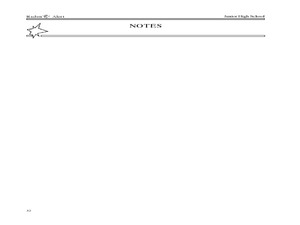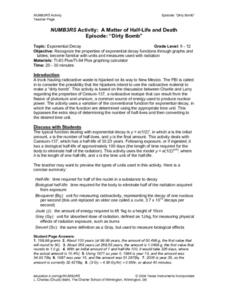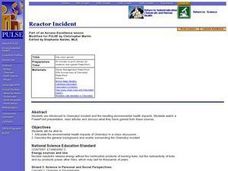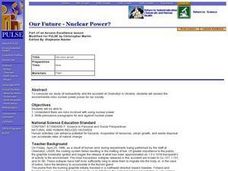Curated OER
Quantum Mechanics
Mostly what you will find here is a history of quantum mechanics. Influential scientists are introduced (along with some of their recorded quotes), the progression of atomic models is reviewed, and finally experssions and equations are...
Curated OER
The Who's Who of Quantum Physics
This wonderful recap of powerful figures in scientific history includes pictures, important dates, and the information about their inventions or impact. Atomic structure and the photoelectric effect are introduced. The first slide gives...
Curated OER
Group 7, The Halogens
The ten slides in this presentation make a consice introduction to the halogen group of the periodic table of elements. The location of the group is displayed, and then the characteristics of the different halogen group members are...
Curated OER
Selected Elements
This collection consists of a slide on each of the following unrelated, but fascinating elements: einsteinium, curium, radium, radon, nobelium, seaborgium, silicon, magnesium, and postassium. You will not find detailed information on the...
Curated OER
The Noble Gases
When breaking down the details of the periodic table of elements, this presentation will explain special characteristics for each of the noble gases. The annotations are quite elementary, so this can easily be used in an introductory...
Education World
Every Day Edit - Marie Curie
In this everyday editing worksheet, students correct grammatical mistakes in a short paragraph about Marie Curie. The errors range from punctuation, spelling, grammar, and capitalization.
Curated OER
Have You Heard about the Clinton, New Jersey Story?
In this radon worksheet, students read about radon in the city of Clinton New Jersey. They compose a play about a family in Clinton New Jersey who is face with high concentrations of radon in their home and how they deal with it....
Curated OER
Exponential Decay
Students study exponential decay and its application to radiocarbon dating. In this exponential decay lesson, students use candy to model the time it takes for something to decay. Students also graph the data they collect and...
Curated OER
Kinetics Practice 2-Key
In this kinetics instructional activity, students solve seven problems related to chemical reactions and their rates. Students identify rate laws for mechanisms, they draw reaction diagrams, and they determine rate constants.
Curated OER
Breaking News: Second Explosion at Japan Nuclear Plant (14th March, 2011)
Young scholars explore current events by sharing information about the Japanese nuclear plant. In this nuclear energy lesson, students discuss the pros and cons of nuclear energy plants and whether or not they can typically withstand...
Curated OER
NUMB3RS Activity: A Matter of Half-Life and Death
Students investigate exponential decay. Students explore the biological half-life of Cesium-137. Students investigate the Goiania Accident of 1987 which is considered one of the worst incidents in the history of the Atomic...
Curated OER
Dancing in the Desert: The Genie
Fifth graders study nuclear destruction using visual literacy. For this nuclear destruction lesson, 5th graders work in groups to examine a group of pictures that show the destruction of a home by a nuclear blast. They discuss the type...
Curated OER
Understanding Radon Detection
In this understanding radon detection worksheet, 6th graders read 8 facts about radon, make observations about and draw pictures of hidden objects, use a chart of elements to answer questions about radon.
Curated OER
Marie Curie
In this famous person worksheet, students read a passage about Marie Curie and then complete a variety of in-class and homework activities to support comprehension, including partner interviews, spelling, cloze, synonym...
Curated OER
Elements
In this elements worksheet, students determine the atomic number, mass, number, electrons, protons, and neutrons for elements. Students review the electromagnetic spectrum. This worksheet has 1 graphic organizer and 13 multiple choice...
Curated OER
Reactor Incident
Students are introduced to Chernobyl incident and the resulting environmental health impacts they watch a PowerPoint presentation, read articles and discuss what they have gained from these sources.
Curated OER
Our Future - Nuclear Power?
Students comprehend that there are risks involved with using nuclear power. They write persuasive paragraphs for and against nuclear power. Students analyze the environmental issues and risks with nuclear power.
Curated OER
Advanced Matching-medical Fields Part 1
In this medical fields worksheet, students study the different studies of medicine. Students match 11 terms to the correct definition that is provided.
Curated OER
How Does Radon Get Into Your Home?
Students examine their home and calculates the amount of ventilation found. They also compute the surface area of different objects. They determine what is needed to reduce the amount of radon entering the home.
Curated OER
How Does Radon Get Into Your Home?
Students complete an experiment in which they measure the radon level in their home. They examine the different types of units of measurement and practice using them throughout the activity. They calculate surface area on objects as well.
Curated OER
How Sensitive Are The Lungs to Radon?
Young scholars examine the effects of radon on the lungs. They review pictures of the lungs on a large and small scale. They work together to answer questions to complete the lesson.
Curated OER
Splitting the Atom
Students use the Internet to research the history of the splitting of the atom. They use that research to prepare a presentation on an aspect of that topic. A map is generated to record findings and results.
Other
Nrc: Unit 5 Transportation of Radioactive Materials
A lesson plan to demonstrate the process of transporting radioactive materials and wastes. Includes a Q&A section.
Other
Nrc: Unit 4 Radioactive Waste
A lesson plan and activity to demonstrate the production, handling, and disposal of radioactive wastes.


